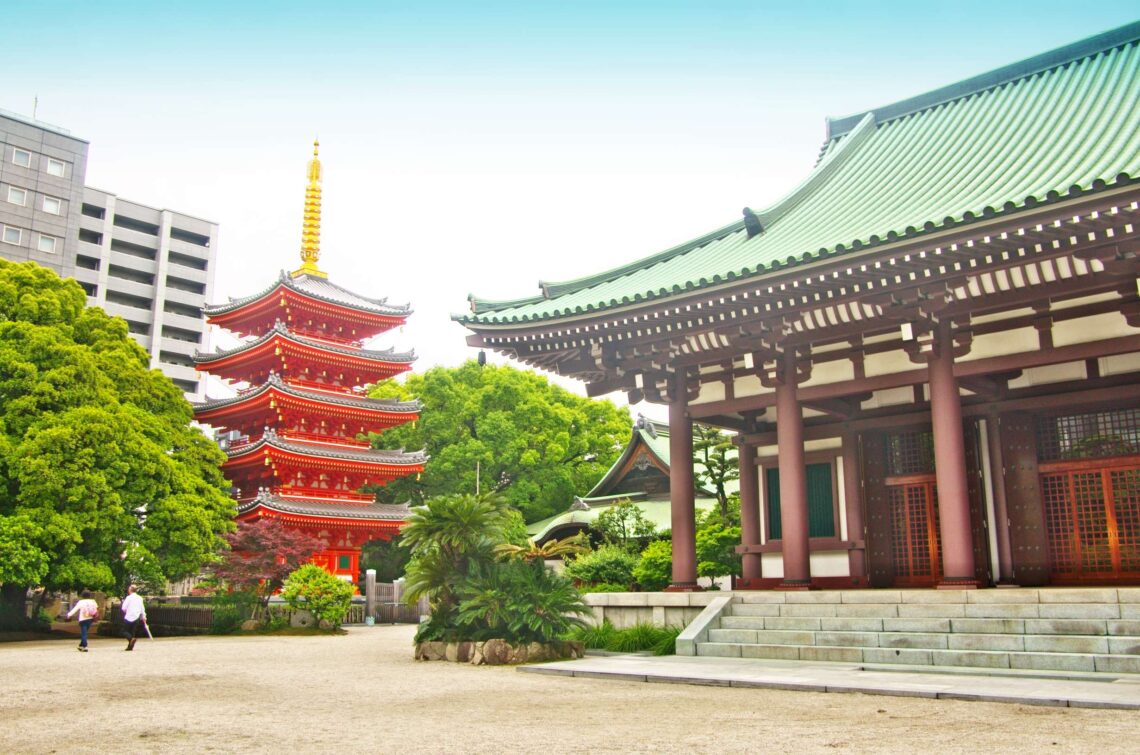
Tochoji – Introducing Japan’s Massive Wooden Seated Buddha
On the side of the busy Taihaku-dori (大博通り) street of Fukuoka city (福岡); lies Tochoji (Tochouji/Tōchōji/東長寺), a rather small and peaceful temple. Do not let it’s soothing appearance deceive you however, as Tochoji is one of the oldest temples in the island of Kyushu (九州). Furthermore, this temple also holds the largest seated wooden Buddha statue in Japan; so much so that even the Dalai Lama himself visited the temple to give a talk in 2018. To learn more about this impressive temple, let’s dwell into its history and complex, shall we?
Table of Contents
History of Tochoji
Originally established in AD 806 as a Shingon Buddhism temple (真言宗) by a revered monk named Kukai (Kūkai/Kuukai/空海), known as the founder of Shingon Buddhism. Tochoji is also officially the oldest Shingon Buddhism temple in the island of Kyushu. As for Kukai himself, he was one of the monks that was sponsored by the government to go on an exchange to China to further studies in Buddhism. Upon his return to Japan, the revered Kukai established this temple in efforts to spread Buddhism across the country.
The name of the temple, Tochoji (東長寺), literally translates as ‘East Long’; is a reference to Kukai’s intention to spread Buddhism to the Eastern part of Japan. While the temple was originally constructed in the coastal area, it was unfortunately burnt down by fire. Later, the local warlord Kuroda Tadayuki (黑田忠之) ordered its reconstruction in its current location during the 17th century. Subsequently, this temple became the burial grounds for the lords of the Kuroda Clan (黒田氏).
Exploring Tochoji And Its Architectures
Tochoji’s location is the epitome of convenience, as it is located along the main Taihaku-dori (大博通り) street and right next to the Gion subway station (祇園駅). Despite being in the middle of a city, the complex’s environment is surprisingly peaceful and soothing; making it ideal for a little stroll. The temple features a garden-like complex; housing several structures with fascinating architectures to look out for. Check out some of its highlights as below:
- Firstly, enter into the temple and pay respects to the graves of the historical Kuroda clan.
- Next, look out for this unique architecture and the symbolism behind it.
- Afterwards, check out the temple’s iconic vermillion pagoda.
- Don’t miss out on the main hall’s treasures as well.
- Visit the largest seated Buddha statue in Japan, and also walk along the pilgrimage across the Buddhist hell.
- Consider these alternative seasons to visit the temple; especially if you are looking to enrich your travel experience.
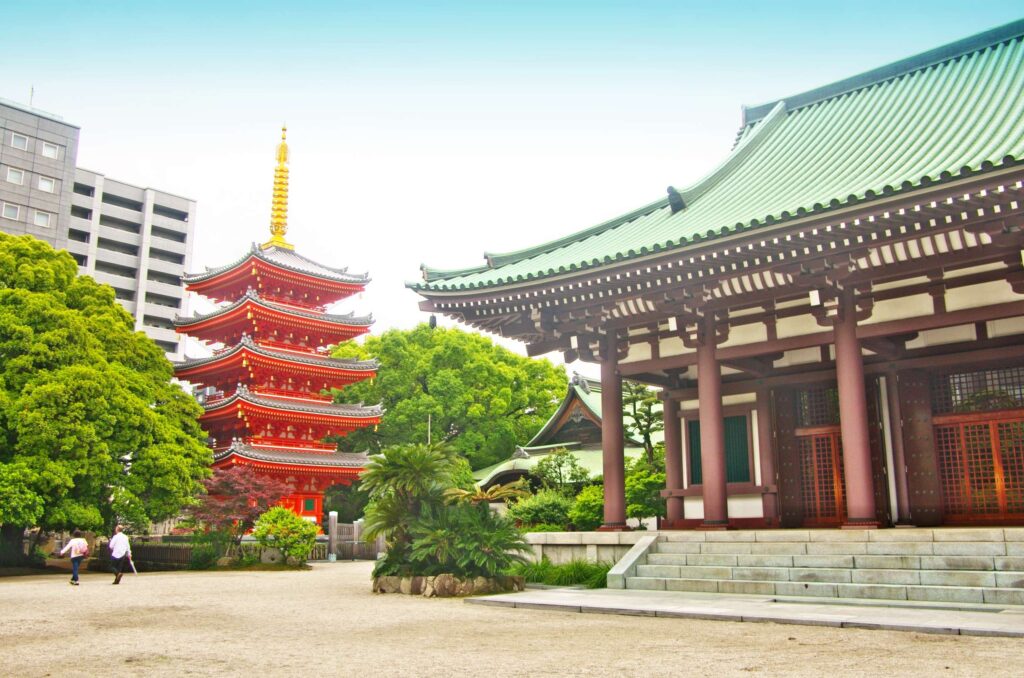
Entering Tochoji
To enter Tochoji, look out for the below traditional wooden gate (which is impossible to miss amidst all the nearby office buildings). On the left of the entrance, one can see the stone inscription stating the characters 「南岳山 東長密寺」 or Tochoji of Nangaku-zan. The ‘Nangaku-zan’ portion of the name refers to the sango (山号) or the mountain name of Tochoji. It is common to see temple’s having a mountain name in Japan; as mountains are revered as sacred places in Japan and also many temples in Japan are built inside mountains.
Because of the strong connection of mountains with religion, subsequently many temples also feature a sango as a prefix, followed by their actual name. For Tochoji’s case, the full name of the temple is in fact Nangaku-zan Tochoji (南岳山 東長寺).

As we pay a visit to the complex, be sure to also pay respects to the graves of the Kuroda clan (黒田氏) family members. The existing complex was rebuilt by the Kuroda clan and eventually became the family temple of the Kuroda clan. It also houses the graves of the 2nd lord Takayuki (黒田忠之), the 3rd lord Mitsuyuki (黒田光之) and the 8th lord Harutaka (黒田治高). You could say we get to enjoy this marvel of an architecture thanks to them. So much so that their graves are classified as ‘Designated Cultural Assets’ by the local municipal.
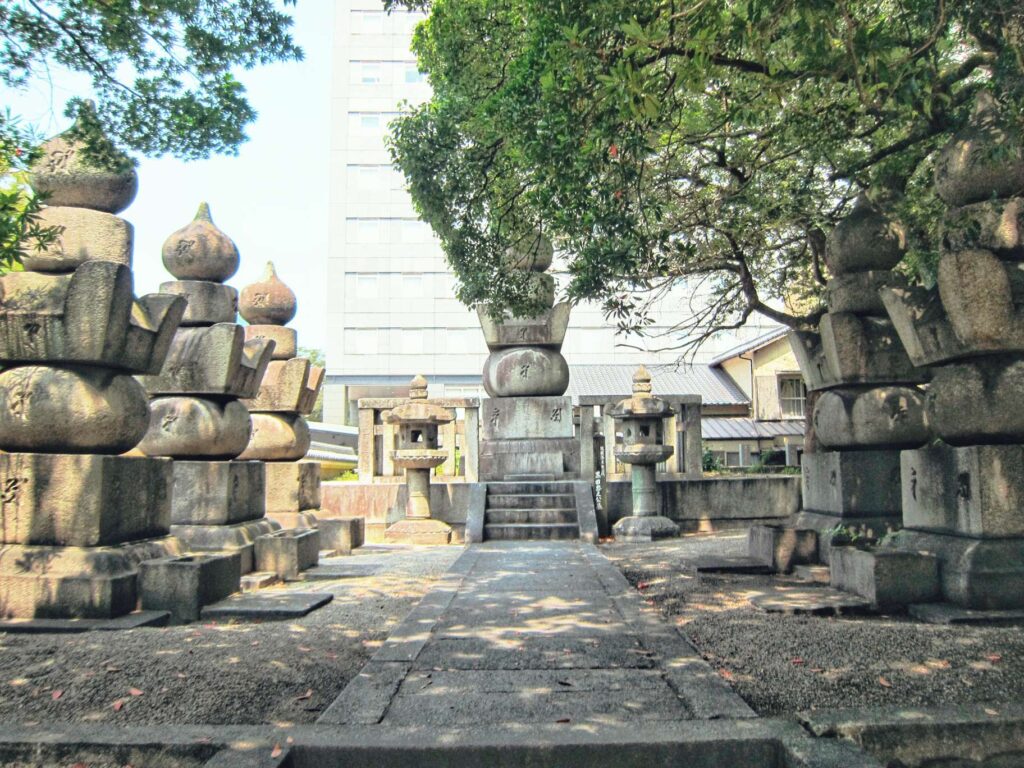
Look Out for This Elegant Hexagonal Sanctum
And just right next to the entrance of the temple is this fascinating sanctum known as the Rokkakudo (六角堂). This charming little rustic hut serves as a storage for Buddhist sutras. In fact, the name Rokkakudo (六角堂) means hexagonal; which represents the structure’s unique hexagonal shape.
Because Buddhism believes there are 6 realms in which a person can be reborn based on the deeds of their previous lives. The 6 realms include the celestial beings, warlike demigods, human beings, animals, hungry ghosts and last but not least, hell itself.
The construction of this building was originally initiated in AD 1842 by a local merchant named Bungoya Eizo (豊後屋栄蔵). He gathered funds from other merchants and invited a carpenter named Ito Hirazaemon (伊藤平左衛門), who specialised in temple building to construct this sanctum. The structure itself contains 6 double-hinged doors; each decorated with refined Buddhist artworks and calligraphies while housing a total of 6 statues which are as follows:
- Yakushi Nyorai (薬師如来) – Buddha of Medicine and Healing
- Monju Bosatsu (文殊菩薩) – Buddha of Wisdom
- Byakue Kannon (白衣観音) – White-Robbed Kannon aka Goddess of Mercy
- Jizo Bosatsu (地蔵菩薩) – Protector of deceased children
- Hokushin Reifu (北辰霊符) – North Star deity
- Kobo Daishi (弘法大師) – Aka the founder of the temple, Kukai himself
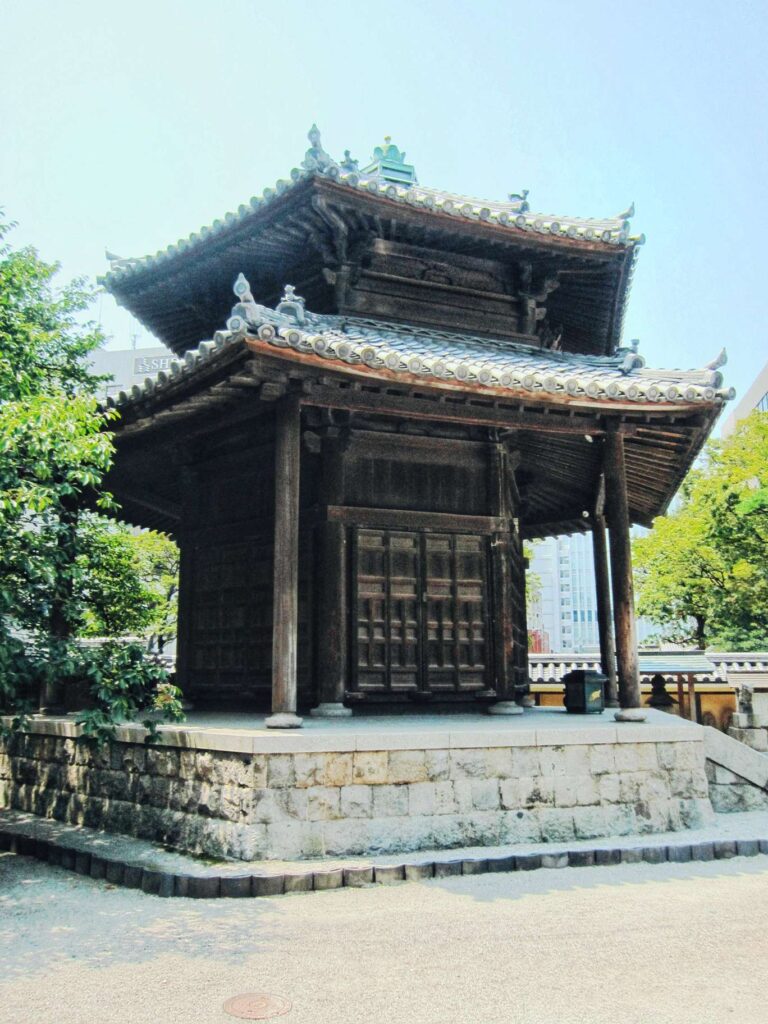
The sanctum is usually remained closed with the exception of every 28th of the month; whereby the temple will open it up for public viewing. So if you are keen in checking the interiors, be sure to visit the temple on the 28th.
Have A Photo With the Temple's Iconic Crimson Pagoda
Next, check out the outstanding vermillion pagoda within the grounds of Tochoji. This five-storied pagoda (Gojuu-no-tou/Gojū-no-tō/五重塔) enshrines the Cosmic Buddha, Dainichi Nyorai (大日如来) and is actually a relatively new structure; being completed in May 2011. Towering at 25.9 meters, the structure gained poster boy status in Fukuoka, simply for its stunningly gorgeous architecture.
The vermillion sections of the tower were made using high-quality cypress wood (hinoki/檜) from Nara (奈良) and Kochi (高知). For a fun fact, the amount of cypress used weighs around a staggering 80 tons; that is slightly more than the weight of a space shuttle. Be sure to take your time exploring different angles of the pagoda; as the vermillion architecture together with the surrounding lush trees offer a plethora of opportunities to snap some gorgeous Japonesque photos.



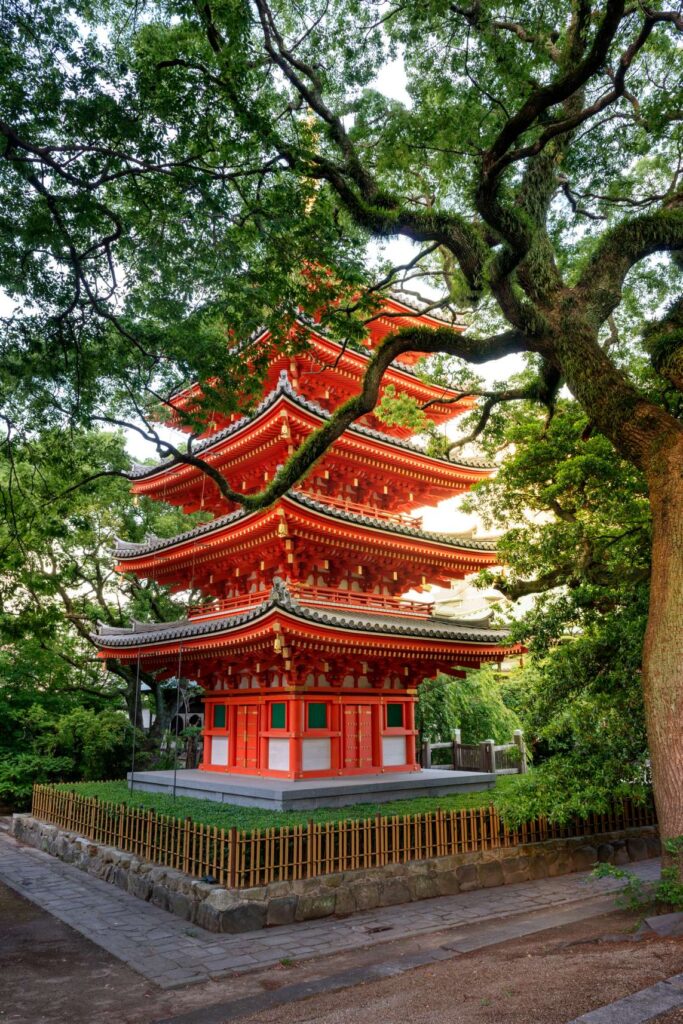
Check Out Tochoji's Main Hall
Next, we check out the temple’s rather quiet main hall. In contrast with the previous two entries, the hall itself isn’t an architecture marvel on its own. As a matter of fact, the hall is only opened during special occasions when there are chanting sessions.
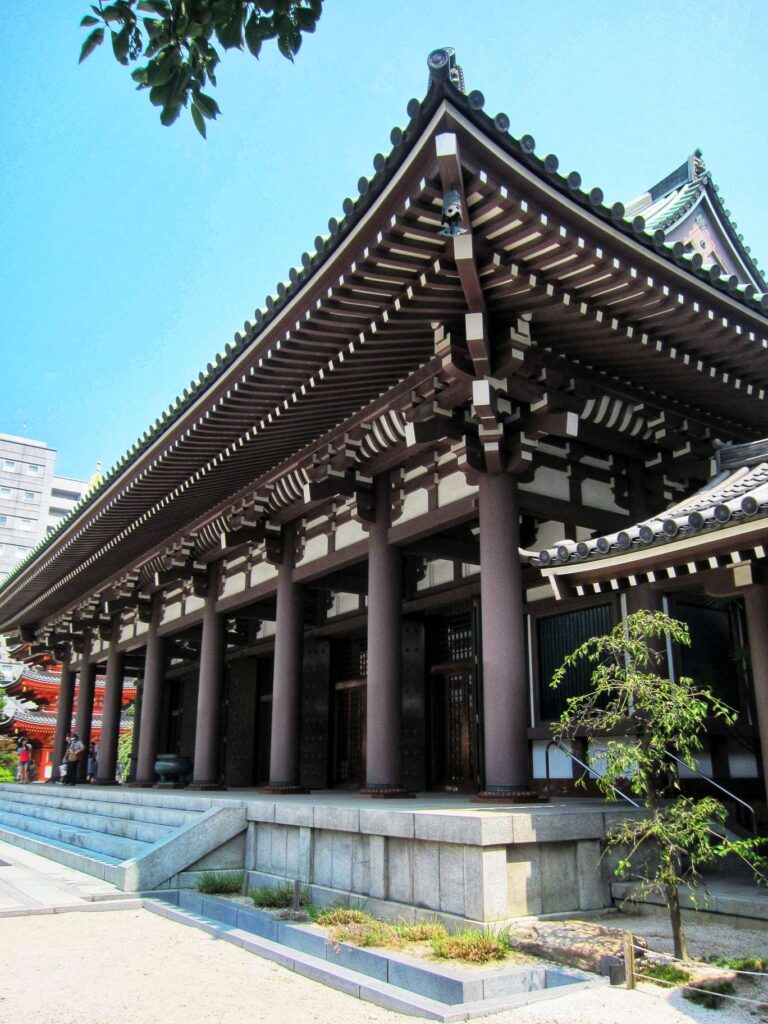
What makes the hall worth checking out however, are the deity statues that it houses. Take a peek through the doors of the hall and you will see three statues enshrined here. The three statues enshrined here are a wooden thousand-arms Kannon/Goddess of Mercy statue (千手観音) in the middle, a seated statue of the temple’s founder Kukai on the left and Fudo-Myoo, the fiery vanquisher of evil (不動明王) on the right.
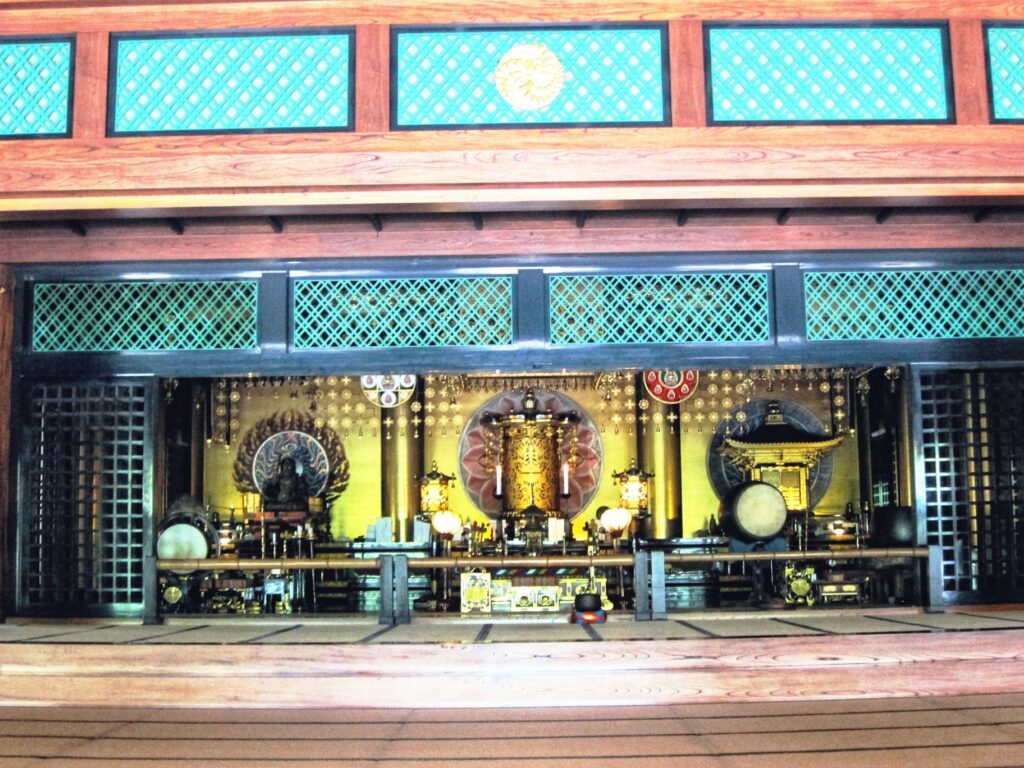
Interestingly enough, both the statues of Kannon and Kukai are concealed in miniature shrines. This practice is called the Hibutsu (秘仏); and the miniature shrines are called Zushi (厨子). The origin of this practice remains unknown; but is widely believed to have been originated from Shintoism (神道). In Shintoism, gods are believed to be intangible and the main halls of shrines are only opened for special purposes. Unless there is a special occasion, these statues are always kept concealed from public views.
During these days, the temple will open up the shrines of the statues for public viewing. This is the Go-Kaicho ceremony itself (opening the shrine or 御開帳) and it only occurs on these dates:
- 3rd February – during the Setsubun (節分) festival (take note date of the festival may sometimes fall on 2nd or 4th)
- 15th June – birthday of the founder, Kukai
- 20th October
Visit Japan's Largest Seated Buddha
Afterwards, head towards the upper floor of the temple’s exhibition hall through the stairs right next to the main hall. While doing so, take the time to appreciate the beautifully-designed traditional corridor, accompanied with the presence of the charming oval-shaped hanging lanterns.

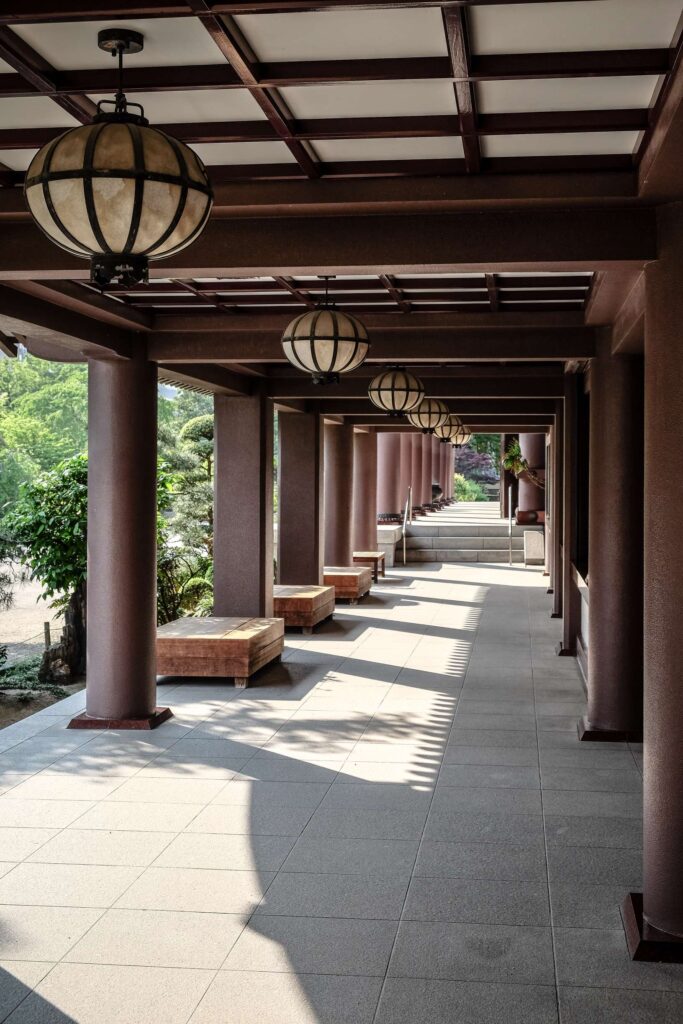
Here lies the magnificent Fukuoka Daibutsu (福岡大仏) or Fukuoka Giant Buddha. At the height of 10.8 metres and weight of 30 tons, this statue was completed in 1992 and is regarded as the largest seating Buddha statue in Japan. One should spend some time here to admire the detailed carvings of the statue; from the solemn expression of the Buddha to the intricate details of its halo filled with smaller Buddha statues.
Unfortunately, I did not managed to capture a photo of the statue due to the no-photo policy of the hall. However, I managed to find the below photo licensed by Zaptomatic in Flickr; which should give you a good idea of what the statue is like.
Walk Along the Corridor of Heaven and Hell
As we explore the statue, head towards the left side through a small passage. This temple features a unique highlight from others; and that is it’s pilgrimage across the Buddhism hell. Walk along the little passage and you will soon encounter rather impressive and detailed paintings depicting suffering of sinful souls. Inside these paintings are men and women who have committed sinful acts in their lifetime being tortured by little devil-like creatures in various unimaginable ways.
After witnessing these horrifying pictures, head through a narrow and winding corridor that is filled in utter darkness. For those who are not comfortable walking in the dark, be sure to hold the railing at the side to navigate across. Walking across this passage without the railing is undeniably an act reserved only for the most daring person. Apparently there is also a ‘Buddha’s ring’ installed across the passage, and if you managed to find it, it is said to guide you to the promised land in Buddhism.
In fact, I felt a sense of nervousness tingling along my body as the uncertainty of what lies ahead looms in my mind. Alas, towards the end of the passage, I breathed a great sigh of relief upon encountering a vibrant painting depicting of heaven in Buddhism. This serves to symbolise the belief that one can reach the heavens and achieve enlightenment through the guidance of the Buddha. As phones and recording are not allowed here, I do not have pictures to show this. In fact, the best way to experience it is to walk the path itself; which I highly recommend for its sheer uniqueness.
Other Notable Times to Visit Tochoji
Setsubun Festival
Another time to consider is during the annual Setsubun festival (節分 or seasonal division festival). This festival occurs every year 2nd and 3rd February; whereby locals will conduct bean-throwing ceremonies lavishly across the temple grounds in efforts to ward-off evil spirits together with the presence of 7 lucky gods (Shichi-fukujin/七福神). Accompanying the ceremonies will be lively stores selling beans (mame/豆), sweet fermented rice drink (Amazake/甘酒) and also lucky charms. Also for a fun fact, this is one of the few times the sanctum and the concealed shrines are opened for display.
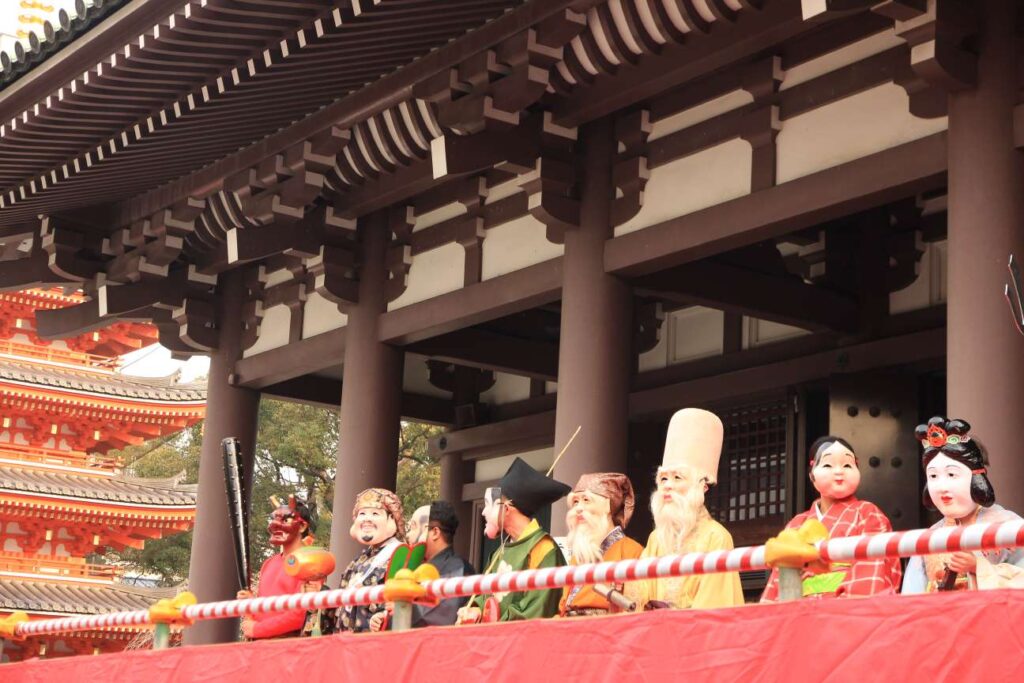
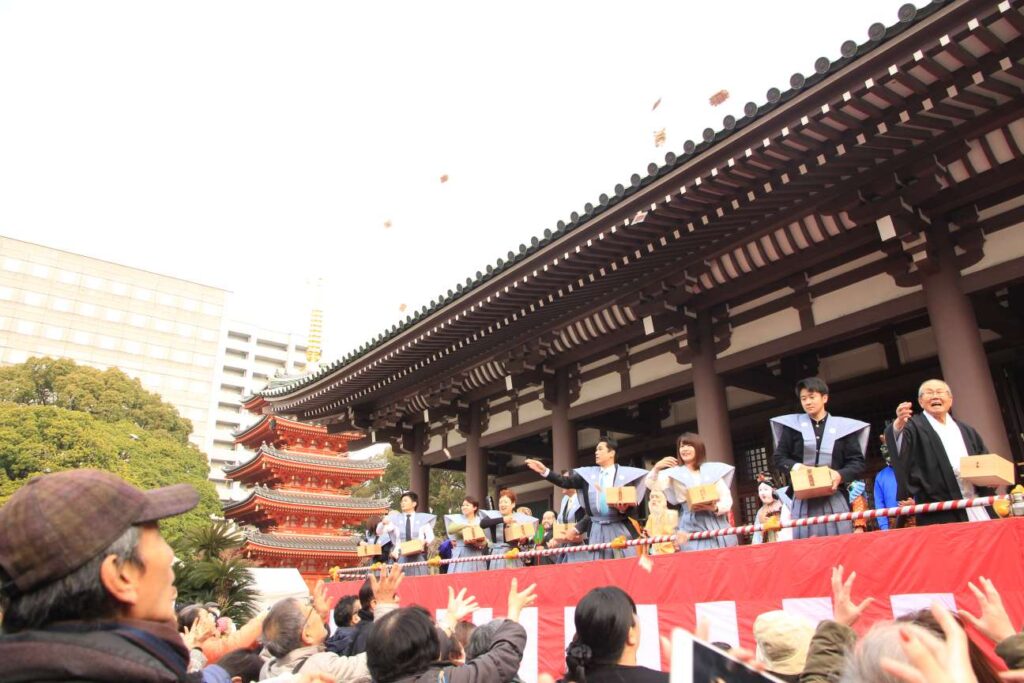
Cherry Blossom Season
For a more exquisite and enchanting experience, visiting the temple during spring will be a great idea. Between late-March and early-April every year, cherry blossoms will bloom across the temple complex; dyeing the entire rustic complex and giving it a more sweet and refreshing look. Look out especially for the surrounding of the pagoda for some stunning sceneries.

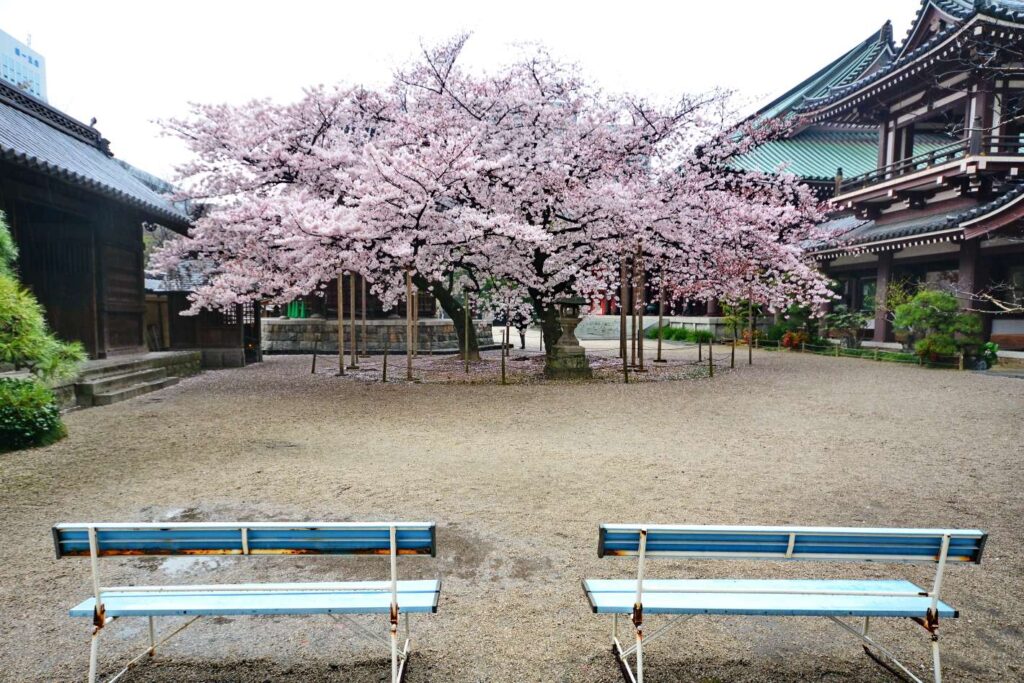
Festivals of Light
For the night owls, look out for both the Hakata Tomyo Watching (博多灯明ウォッチング) and also the Hakata Old Town Light-Up Walk (博多旧市街ライトアップウォーク) night events. The former happens in October where locals light up thousands of votives of various colours and arranging them in various formations across the temple grounds; certainly more for those who appreciate arts. The latter occurs in November, during which the temple grounds will be lit up in various colours; allowing one to savour a unique experience of exploring a lit-up temple at night. Dates do defer over the years; hence, please check here for the Hakata Tomyo Watching and here for the Light-Up Walk event.
An important tip to look for the date in the websites are the characters for year (年/nen), month (月/gatsu), date (日/nichi) and time or hour (時/ji). For example; 2022年10月18日 translates as 18th October 2022 while 18時 – 21時 means 6pm – 9pm.


Getting There
By Train
Fukuoka is well-connected through the JR train line; which one can get down at the large Hakata station (博多駅). Afterwards, take the subway (chikatetsu/地下鉄) and disembark at the next station, Gion (祇園駅). Total fee for subway costs 210 Yen. Tochoji is simply a few minutes walk from the subway station. Alternatively, you can also walk for about 10 minutes to the temple from Hakata station.
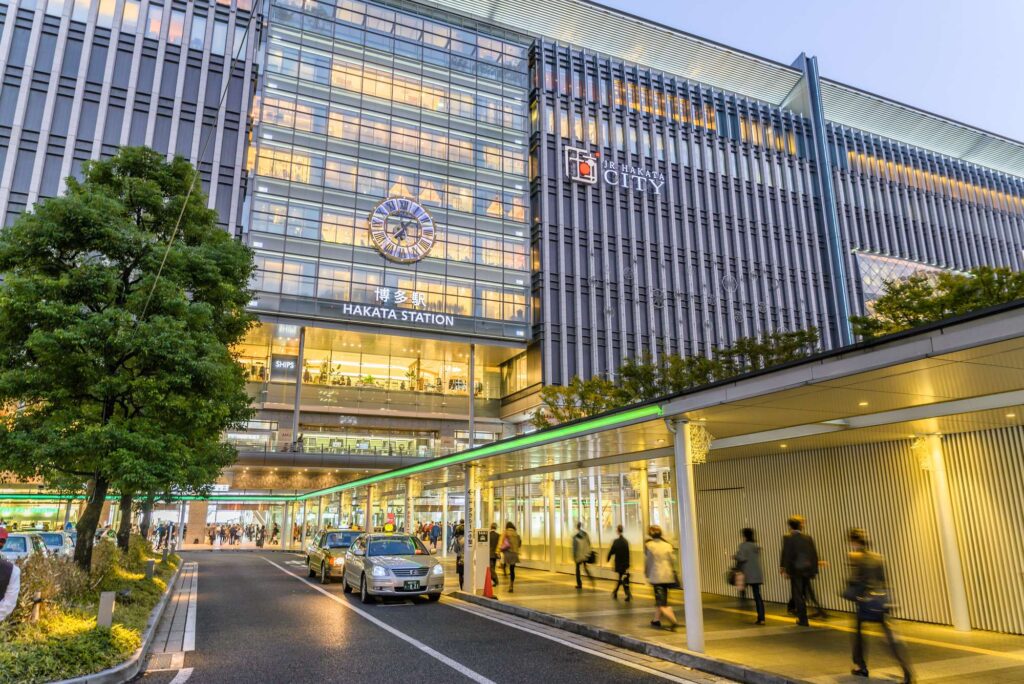
In fact, I would suggest getting the JR Pass (JR パース) especially if you are commuting to Fukuoka from other major cities. The JR Pass is a handy all-you-can-ride pass on all JR lines in the country; which presents a great opportunity to save costs and also breeze through the hectic train stations. In fact, a friend of mine traveled two-way between Osaka and Oita, together with a few other cities; and managed to save 10% of his costs. The JR pass is especially worth considering if you:
- Are traveling between cities and other regions; especially when train fares between regions are quite expensive.
- Love trying out the bullet train/shinkansen (新幹線) experience.
- Travel solo, in a couple or a smaller group.
By Car
Another alternative, especially for those who prefer a more flexible option in travelling. Those driving can simply park at Tochoji’s designated parking (a total of 30 slots) which is convenient and free.
Driving is another alternative to travel around Japan; especially if you are travelling with a family or group of friends. In fact, a friend of mine used Tocoo; Japan’s leading rental car website which is reliable and provides a wide selection of cars, ranging from small economical cars to the larger family cars.
Are you unsure of getting the necessary license and familiarising with the rules of driving in Japan? Fret not as they provide comprehensive and elaborate guides in their site on what you need to start your driving journey in Japan. Click here to embark on a wonderful journey of driving through the countryside of Japan.
Overall Thoughts
Tochoji, despite being a major attraction in Fukuoka; remains an easily accessible destination and also a relatively peaceful spot to explore. While many of its buildings are relatively new, it makes up for it with its long standing history, outstanding architectures and unique attractions such as the passage through hell. In fact, I would strongly suggest to visit this temple together with the nearby hidden Shofukuji (聖福寺) which also features its own rich history. Be sure to subscribe, as I will cover more hidden destinations like this in the future.
Loving the content here?
Subscribe and get your free hidden gems in Japan bucket list here.


You May Also Like
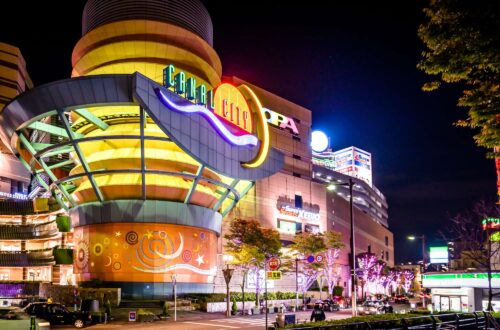
Canal City – A Complete Guide to Fukuoka’s Architecture Marvel
March 5, 2023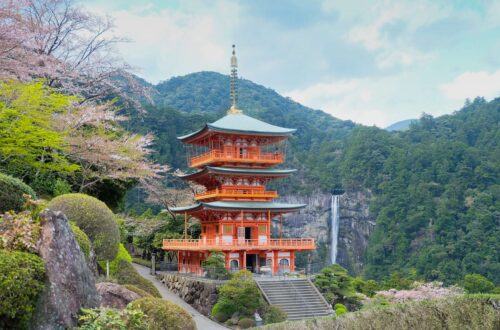
Kumano Nachi Taisha – A Complete Guide to Japan’s Stunningly Beautiful Mountain Shrine
May 23, 2025
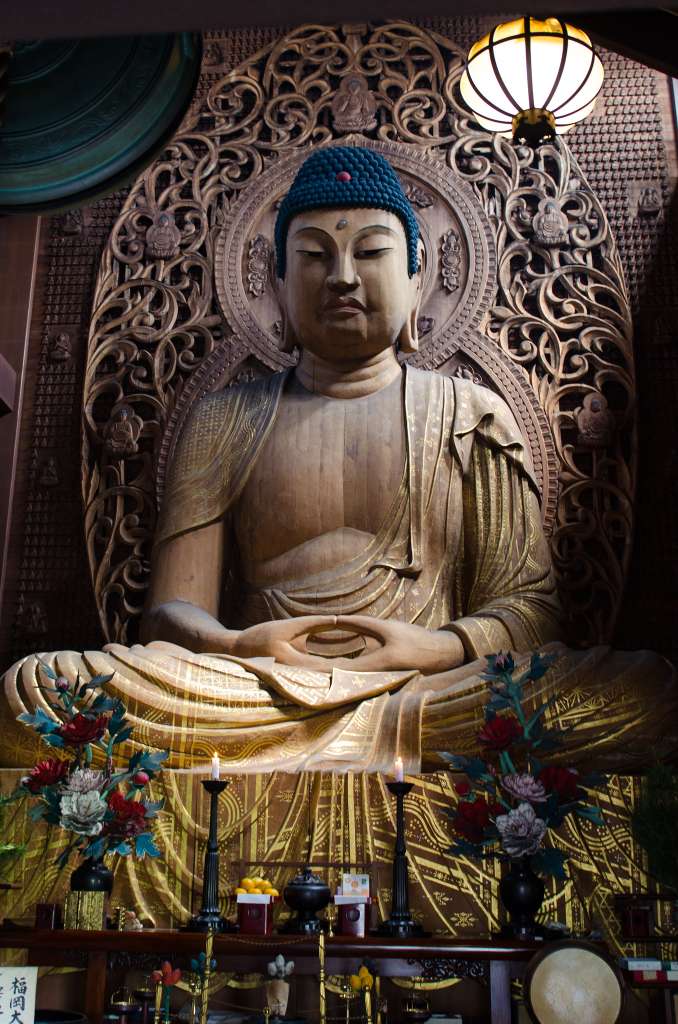
2 Comments
Sheila C K Wong
With you in the photo, is proof that you have indeed been here. Good idea to include that in a few of your posts. Do make your own pose more candid. Perhaps a full length photo sometimes?
Yentravelsjapan
Hi Sheila, thanks for the comments. Noted on that, as actually this visit was few years back solo before COVID; which I am actually taking more photos of myself recently.